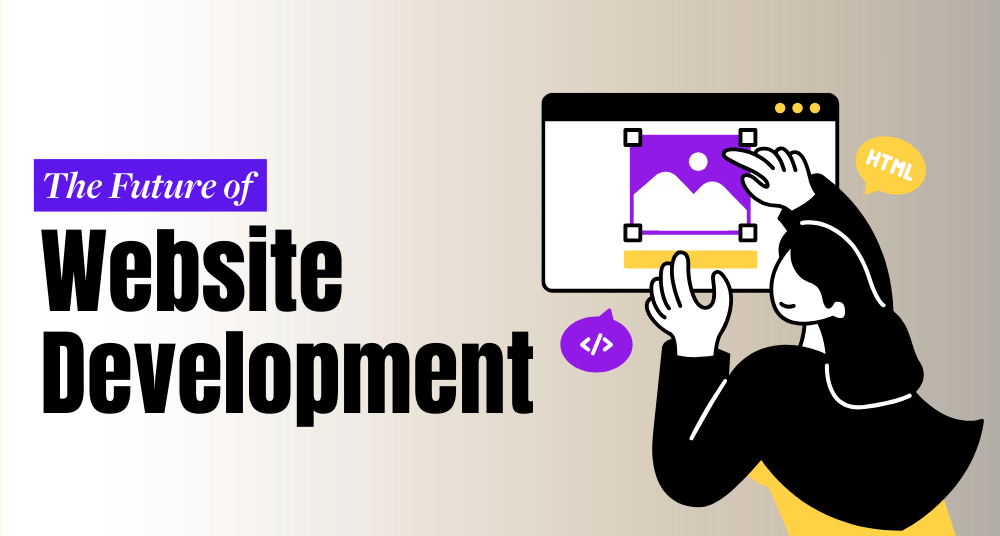In today’s hyper-digital world, website development is evolving at breakneck speed. What was considered innovative five years ago is now standard, and what is standard today might be obsolete tomorrow. As we move forward into a future defined by AI, automation, immersive experiences, and lightning-fast performance, understanding the key technologies shaping the next generation of website development is critical—for businesses, developers, and users alike.
In this blog, we’ll explore the future of website development, highlighting groundbreaking technologies, tools, and trends that are set to redefine how websites are built, experienced, and monetized.
Artificial Intelligence and Machine Learning
AI is no longer just a buzzword—it’s a fundamental driver of innovation in web development.
Key Innovations:
- AI-powered design tools like Wix ADI and Bookmark are already creating websites with minimal human input.
- AI chatbots and virtual assistants offer 24/7 customer interaction with natural language processing (NLP).
- Predictive personalization uses user behavior data to dynamically change content, layout, and call-to-actions.
What to Expect:
- AI-generated UI/UX based on heatmaps and real-time interaction.
- Smarter recommendation systems to boost conversion rates.
- Hyper-personalized web experiences based on demographics and usage history.
Progressive Web Apps (PWAs)
PWAs bridge the gap between websites and mobile apps, offering app-like experiences in the browser.
Benefits:
Lightning-fast loading even with poor connectivity.
- Offline access.
- Push notifications.
- Installable on a device’s home screen.
Future Outlook:
Expect more companies to adopt PWAs as they reduce the need for native apps, lower development costs, and improve SEO.
Voice Search Optimization
With the rise of Alexa, Siri, and Google Assistant, voice search is transforming SEO and content structuring.
Innovations:
- Websites are being built with structured data to support voice query responses.
- Conversational UI and voice-enabled navigation will become more common.
Developer Strategy:
- Implement schema markup.
- Focus on natural language keyword optimization.
- Optimize for question-based queries.
WebAssembly (Wasm)
WebAssembly allows developers to run high-performance code in the browser, opening doors for complex applications like games, CAD tools, and video editing software to run seamlessly online.
Benefits:
- Near-native performance.
- Language flexibility (C++, Rust, Go, etc.)
- Safer, sandboxed execution.
Use Cases:
- Real-time collaboration tools.
- Advanced animation and graphics.
- Machine learning in-browser.
Jamstack Architecture
Jamstack (JavaScript, APIs, and Markup) is redefining performance and scalability in modern web development.
Advantages:
- Pre-rendered pages for blazing-fast load times.
- Better security.
- Easier scaling and integration with headless CMS platforms like Contentful or Sanity.
Future Focus:
- API-first development.
- Better developer experience with static site generators like Next.js, Hugo, and Gatsby.
- Increased adoption in enterprise-grade solutions.
Headless CMS and Content-as-a-Service (CaaS)
Headless CMS platforms allow content to be decoupled from the frontend, providing flexibility to publish across multiple platforms—web, mobile, smartwatches, or even AR devices.
Popular Headless CMSs:
- Strapi
- Sanity
- Prismic
- Contentful
Future Use:
- Multi-experience content delivery.
- Omnichannel brand presence.
- Seamless API integrations across frontend frameworks.
Motion UI and Micro-Interactions
Static websites are dead. The future belongs to dynamic, engaging interfaces powered by Motion UI.
Innovations:
- Interactive animations on scroll.
- Haptic feedback-like effects in web interactions.
- Lottie animations and GSAP for lightweight, smooth transitions.
Why It Matters:
It enhances user engagement and reduces bounce rates by delivering more interactive and intuitive experiences.
Augmented Reality (AR) and Virtual Reality (VR)
AR and VR aren’t just for gaming—they’re changing how we shop, learn, and engage online.
Use Cases:
- Virtual product trials in e-commerce.
- Real estate walkthroughs.
- Interactive training modules.
Key Technologies:
- WebXR
- Three.js
- A-Frame
As 5G becomes mainstream, expect these immersive experiences to be more common in e-commerce, education, and tourism websites.
Cybersecurity-Focused Development
As threats evolve, so must the security of websites. Future-ready websites will adopt DevSecOps practices and zero-trust architecture.
Key Trends:
- Biometric authentication integration.
- Real-time threat monitoring.
- End-to-end encryption as a default.
Developer Checklist:
- Use of HTTPS by default.
- Regular security audits.
- Use of secure, updated dependencies.
Sustainable Web Development (Green Coding)
With growing awareness about digital carbon footprints, developers are prioritizing eco-friendly websites.
Strategies:
- Lighter codebases.
- Minimalist design.
- Hosting on green web servers.
- Lazy loading and CDN optimization.
This movement will shape not only ethical standards but also SEO rankings as search engines begin to factor in sustainability.
Low-Code & No-Code Development
These platforms democratize web development, allowing non-tech users to build powerful websites.
Leading Platforms:
- Webflow
- Bubble
- OutSystems
- Glide
Future Impact:
- Rapid prototyping and MVP development.
- Widespread innovation across startups and SMBs.
- Increased collaboration between designers and developers.
Blockchain and Web3 Integration
The decentralized web (Web3) is gradually finding its way into mainstream web development.
Key Features:
- Decentralized hosting (IPFS, Arweave).
- Crypto payment integration.
- Smart contracts for eCommerce and legal services.
Tools:
- Ethereum, Solana
- MetaMask integration
- WalletConnect
As blockchain usability improves, more sites will adopt token-based authentication, decentralized identities, and NFT marketplaces.
Frequently Asked Questions [FAQ’S]
What are the most important future trends in website development?
Key future trends include AI-driven web design, Progressive Web Apps (PWAs), voice search optimization, WebAssembly for high-performance apps, and immersive technologies like AR/VR.
How will AI impact the future of web development?
AI will automate design, enable hyper-personalized user experiences, power intelligent chatbots, and optimize content delivery through real-time behavioral analysis.
What is a Progressive Web App (PWA), and why is it important?
PWAs are web apps that function like native apps—offering offline access, push notifications, and fast performance—making them essential for mobile-first strategies.
Why is voice search optimization important for websites?
With the increasing use of voice assistants, optimizing for voice search helps your content appear in voice queries, enhances accessibility, and improves SEO performance.
How do headless CMS platforms benefit modern websites?
Headless CMS separates content management from presentation, allowing developers to push content across multiple platforms (web, mobile, IoT) using APIs for more flexibility and speed.
What is Jamstack, and how is it changing web architecture?
Jamstack stands for JavaScript, APIs, and Markup. It enables faster, more secure, and scalable websites by pre-rendering pages and using dynamic APIs for backend services.
What role does WebAssembly (Wasm) play in website development?
WebAssembly allows developers to run high-performance code (written in languages like Rust or C++) in the browser, unlocking powerful web apps like games, design tools, and ML engines.
How is cybersecurity evolving in web development?
Future-focused websites will integrate DevSecOps, real-time threat monitoring, biometric authentication, and end-to-end encryption to counter increasing cyber threats.
What is sustainable web development, and why does it matter?
Sustainable or “green” web development focuses on reducing a website’s carbon footprint through lightweight code, minimalistic design, and energy-efficient hosting, aligning with eco-conscious business values.
Can non-developers build future-ready websites?
Yes! Low-code and no-code platforms like Webflow, Bubble, and Glide allow non-technical users to create sophisticated, scalable websites with drag-and-drop interfaces and minimal coding.
Final Thoughts
The future of website development is not just about aesthetics or functionality—it’s about delivering seamless, immersive, personalized, and secure experiences at scale. Developers, designers, and businesses must stay ahead of the curve by embracing these key innovations and aligning with the evolving expectations of users.
At Synarion IT Solutions, we don’t just follow trends—we set them. With expertise in emerging technologies and a vision for the digital future, we help brands build forward-thinking websites that are fast, scalable, and future-proof.






What do you think?
It is nice to know your opinion. Leave a comment.